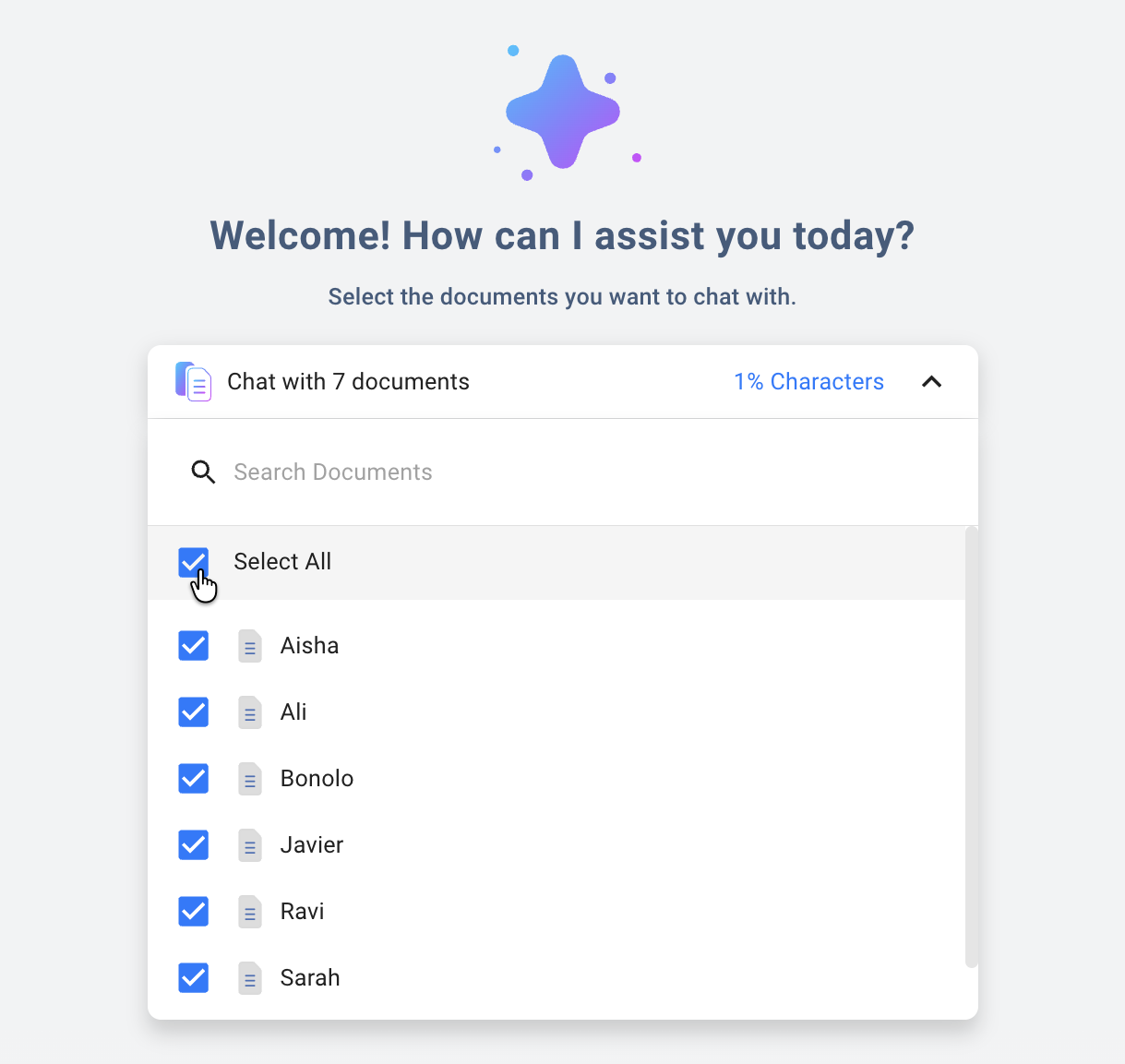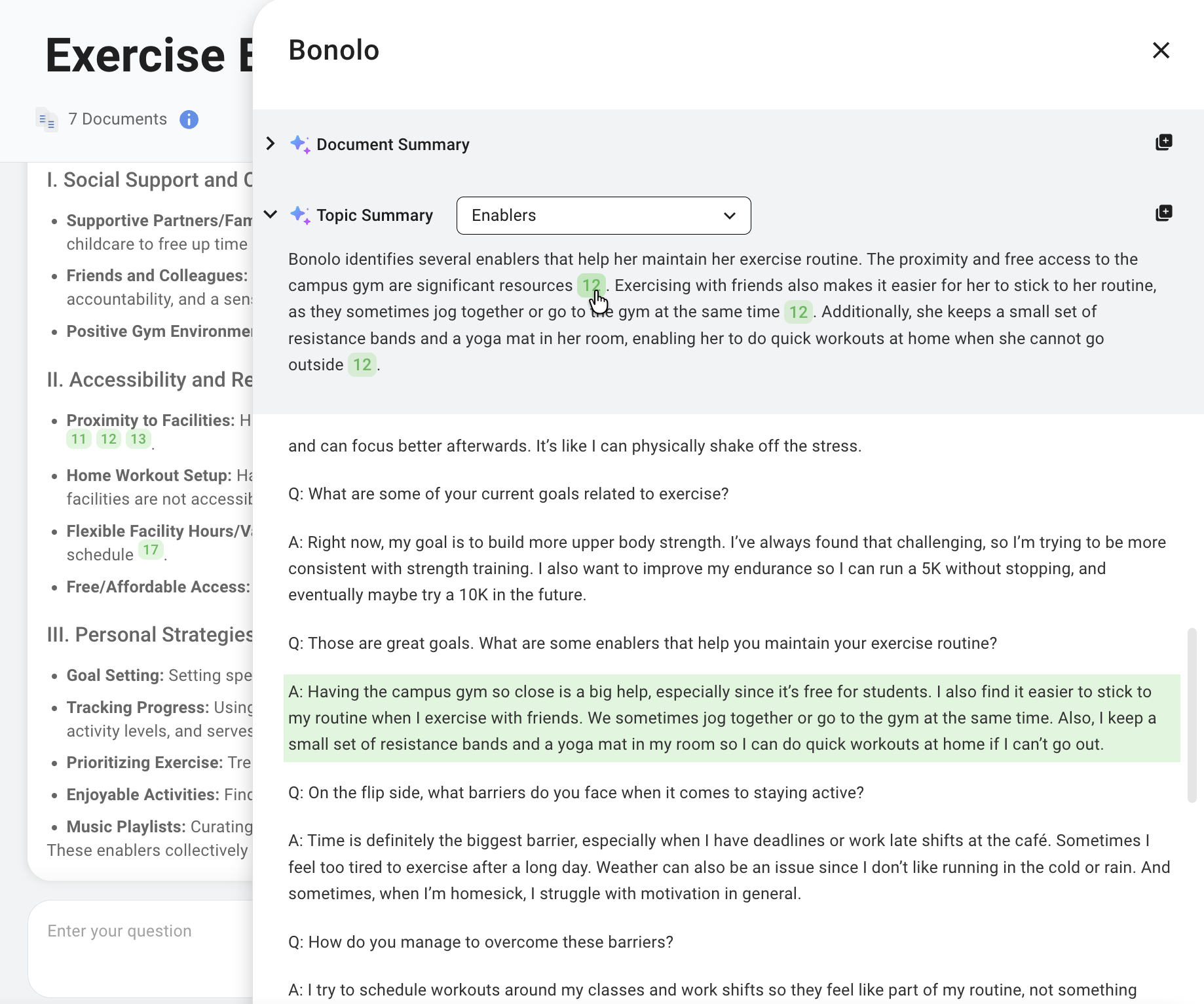Chatting with Your Data
MAXQDA Tailwind’s ![]() Chat enables you to interact with your project data using conversational AI. This page will guide you through using it effectively.
Chat enables you to interact with your project data using conversational AI. This page will guide you through using it effectively.
💬 Starting a Chat
Before you can start a chat, upload at least one document to your project’s ![]() Data dashboard. Tailwind bases its responses on the documents you select.
Data dashboard. Tailwind bases its responses on the documents you select.

To start a chat:
- Navigate to the
 Chat section in the sidebar.
Chat section in the sidebar. - If it’s your first chat in a session, you’ll see the setup screen automatically. If a chat is already active, click + New Chat to start a separate conversation.
- Select the documents you want to include.
- Select All is chosen by default. Toggle it off to choose specific documents.
- Click Apply to confirm your selection.
Note:
- The percentage indicates how much of the total character limit your selected documents use. If you exceed the limit, adjust your selection accordingly.
- You cannot change the selected documents once a chat has started. To chat with different documents, start a new chat.
Tips:
- When adding documents to your chat, use the search bar in the dropdown menu to quickly find specific files.
- After starting a chat, click
 Info below the chat name to view the included documents in a drop-down list.
Info below the chat name to view the included documents in a drop-down list.
✏️ Using the Chat
- Type your prompt in the message box (up to 2,000 characters).
- Click Send to begin.
- To cancel a response in progress, click Stop.
- Click on
 Copy to Clipboard to copy a response for use elsewhere.
Copy to Clipboard to copy a response for use elsewhere.
🔍 Navigating References
Tailwind responses often include interactive green reference numbers linking to the source documents. Here’s how to navigate them:
- Hover over a reference to see which document it refers to (and if applicable, the paragraph number).
- Click on a reference to open it in context.
- The “Document View” panel will slide open, showing:
- AI Summary (top): Provides an overview of the document. Click any reference to see where that information comes from.
- Topic Summary (middle): Provides an overview of a chosen topic as it appears in the specific source document. Choose a topic using the dropdown menu.
- You can use the
 Copy to Clipboard icons to copy the entire document and topic summary.
Copy to Clipboard icons to copy the entire document and topic summary.
- You can use the
- Original Document (bottom): Automatically scrolls and highlights the matching text in green when you click a reference in the summary above, as seen in the image on the left.
- To close the “Document View,” click the
 Close icon located in the panel’s upper right corner.
Close icon located in the panel’s upper right corner.

🧰 Managing Chats
Tailwind Chat History
- Each chat is automatically saved to the chat history in the sidebar, sorted by “Last updated.”
- You can have up to 100 chats in your history. To start a new one after reaching the limit, delete an older chat.
- Use the
 search bar to quickly find past chats.
search bar to quickly find past chats. - Reopen chats to continue conversations, provided the original documents are still available.
Note: If a chat is missing its original documents, it will become read-only.
Renaming a Chat
- Click on the chat title to enter edit mode, as shown:
- Type the new name.
- Click
 Done to save or
Done to save or  Cancel to discard changes.
Cancel to discard changes.

Exporting a Chat
To export a chat as a PDF, open the chat you wish to export, then click ![]() Export. Tailwind will generate a PDF of your conversation for download or print.
Export. Tailwind will generate a PDF of your conversation for download or print.
Deleting a Chat
To delete a chat, hover over its name in the chat history panel and click ![]() Delete, then confirm.
Delete, then confirm.
Please note that you can only delete chats via the chat history panel.
📌 Additional Notes
- When your chat gets too long, you’ll be asked to start a new one.
- When you return during the same session, your most recent chat will still be open and can be continued.
- Sent messages cannot be edited.
- Tailwind analyzes text only. Image data is removed when you import data.
- Tailwind cannot create visualizations or images.
⚡ Best Practices to Maximize Your AI Chat Experience
- Start a new chat when switching topics to avoid earlier conversations influencing responses. For example, if you’ve been discussing a company’s business strategy and want to ask about marketing techniques, it’s best to start fresh.
- When relevant, specify your preferred output format or style. For instance, “bullet points” or “two sentences.”
- Break down complex tasks into a series of simpler prompts.
- Use clear, concise, and precise language whenever possible.
Frequently Asked Questions
- Are Tailwind’s chat responses accurate?
- Generally, the chat provides accurate responses across a range of scenarios. However, it’s essential to verify the information, including checking any provided references, to ensure its reliability.
- Are references to the original text accurate?
- References usually correspond to the relevant parts of the text. However, they may occasionally point to adjacent or incorrect sections, so it’s important to double-check them.
- Which languages does the chat support?
- Tailwind supports most widely spoken languages. The language of the analyzed text may differ from the one used in the conversation. For example, you can ask questions in Spanish about a document written in English. The response will typically be in your query language, though English may be used for languages that are less common. Additional info: Supported Languages.
- Does the chat always give the same answer to the same question?
- Tailwind’s responses may vary slightly. If you restart the chat and ask the same question, the answer will usually be similar in content, but the wording may differ.
Further Considerations and Usage Guidelines
- When analyzing sensitive content (e.g., violence, hate speech, or bullying), Tailwind may decline to respond.
- If the chat says your request doesn’t match the document content, try rephrasing it.
- Response times can vary depending on server load and request volume.